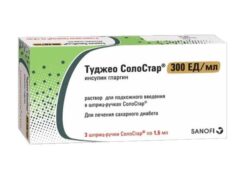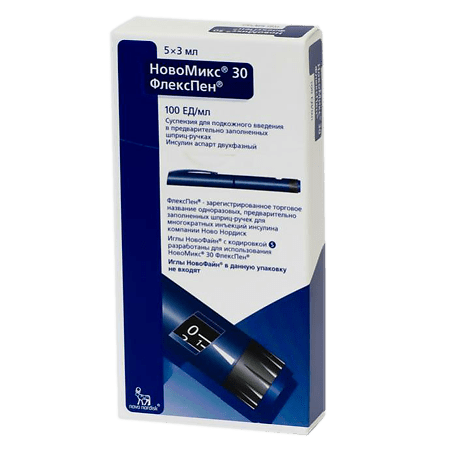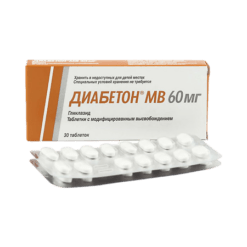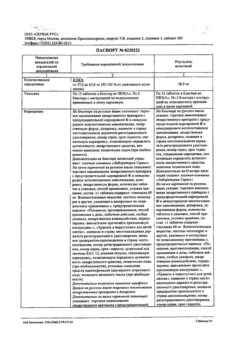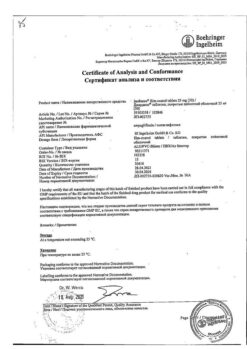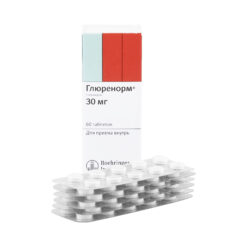Subtotal: €115.89
NovoMix 30 FlexPen, 100 iu/ml suspension 3 ml cartridges in syringe pens 5 pcs
€51.14 €42.62
Description
NovoMix 30 FlexPen is hypoglycemic.
Pharmacodynamics
. NovoMix® 30 FlexPen® is a biphasic suspension consisting of soluble insulin aspart (30% short-acting insulin analog) and insulin aspart protamine crystals (70% medium-acting insulin analog). The active ingredient of NovoMix® 30 FlexPen® is insulin aspart produced by recombinant DNA biotechnology using Saccharomyces cerevisiae strain.
Aspart insulin is equipotential to soluble human insulin based on molarity values.
The decrease in blood glucose concentration is due to increased intracellular transport after insulin aspart binds to insulin receptors of muscle and adipose tissues and simultaneously inhibition of glucose production by the liver. After subcutaneous administration of NovoMix® 30 FlexPen® the effect develops within 10-20 min. Maximum effect is observed within 1 to 4 hours after injection. The duration of action of the drug is up to 24 hours.
In a three-month comparative clinical study involving patients with type 1 and type 2 diabetes who received NovoMix® 30 FlexPen® and biphasic human insulin 30 twice daily before breakfast and supper it was shown that NovoMix® 30 FlexPen® was stronger in reducing postprandial blood glucose concentration (after breakfast and supper).
A meta-analysis of data from 9 clinical trials involving patients with type 1 and type 2 diabetes showed that NovoMix® 30 FlexPen®, when administered before breakfast and dinner, provides better control of postprandial blood glucose concentration (mean increase in prandial glucose concentration after breakfast, lunch and dinner) compared to human biphasic insulin 30. Although fasting glucose concentrations were higher in patients using NovoMix® 30 FlexPen®, overall NovoMix® 30 FlexPen® has the same effect on glycosylated hemoglobin (HbA1c) concentration as biphasic human insulin 30.
In a clinical trial involving 341 patients with type 2 diabetes, patients were randomized to treatment groups of NovoMix® 30 FlexPen® alone, NovoMix® 30 FlexPen® in combination with metformin and metformin in combination with a sulfonylurea derivative. HbA1c concentrations after 16 weeks of treatment did not differ between patients who received NovoMix® 30 FlexPen® in combination with metformin and those who received metformin in combination with a sulfonylurea derivative. In this study, 57% of patients had baseline HbA1c concentrations above 9%; in these patients, therapy with NovoMix® 30 FlexPen® in combination with metformin resulted in a greater reduction in HbA1c concentration than patients who received metformin in combination with a sulfonylurea derivative.
In another study, patients with type 2 diabetes with poor glycemic control who were taking oral hypoglycemic medications were randomized to the following groups: those receiving NovoMix® 30 twice daily (117 patients) and those receiving insulin glargine once daily (116 patients). After 28 weeks of treatment the average decrease of HbA1c concentration in NovoMix® 30 FlexPen® group was 2.8% (initial average was 9.7%). In 66% and 42% of patients who used NovoMix®30 FlexPen® the HbA1c values were lower than 7 and 6.5% at the end of the study, respectively. The average fasting plasma glucose value decreased by approximately 7 mmol/L (from 14 mmol/L at the beginning of the study to 7.1 mmol/L).
The results of a meta-analysis of data from clinical trials involving patients with type 2 diabetes demonstrated a reduction in total episodes of nocturnal hypoglycemia and severe hypoglycemia with NovoMix® 30 FlexPen® compared to biphasic human insulin 30. The overall risk of daytime hypoglycemia was higher in patients receiving NovoMix® 30 FlexPen®.
Children and adolescents. A 16-week clinical study was conducted comparing blood glucose levels after meals on NovoMix® 30 (before meals), human insulin/biphasic human insulin 30 (before meals) and isophane insulin (administered before bedtime). The study included 167 patients aged 10 to 18 years. The mean HbA1c values in both groups remained close to the initial values throughout the study. There were also no differences in the incidence of hypoglycemia when using NovoMix® 30 FlexPen® or biphasic human insulin 30.
A double-blind, cross-over study was also conducted in a population of patients aged 6 to 12 years (54 patients total, 12 weeks for each treatment type). The incidence of hypoglycemia and post-meal glucose elevation in the NovoMix® 30 FlexPen® patient group were significantly lower compared to those in the biphasic human insulin 30 patient group. HbA1c values at the end of the study were significantly lower in the biphasic human insulin 30 group than in the NovoMix® 30 FlexPen® group.
Elderly patients. The pharmacodynamics of NovoMix® 30 FlexPen® has not been studied in elderly patients. However, a randomized, double-blind, cross-over study conducted in 19 patients with type 2 diabetes mellitus aged 65-83 years (mean age 70 years) compared pharmacodynamics and pharmacokinetics of insulin aspart and soluble human insulin. The relative differences in pharmacodynamic values (maximum glucose infusion rate – GIRmax and area under the glucose infusion rate curve for 120 min after insulin administration – AUCGIR, 0-120 min) between asparte insulin and human insulin in older patients were similar to those in healthy volunteers and in younger diabetic patients.
Preclinical safety data
Preclinical studies have not shown any risk to humans based on data from generally accepted studies of pharmacological safety, repeat use toxicity, genotoxicity and reproductive toxicity.
In in vitro tests involving binding to insulin and IGF-1 receptors and effects on cell growth, the properties of Aspart insulin were shown to be similar to those of human insulin. The results also showed that the dissociation of insulin asparte binding to insulin receptors is equivalent to that of human insulin.
Pharmacokinetics
. In insulin aspart, the substitution of the amino acid proline at position B28 for asparagic acid reduces the tendency of the molecules to form hexamers in the soluble fraction of NovoMix® 30 FlexPen® that is observed in soluble human insulin. As a result, aspart insulin (30%) is absorbed from the subcutaneous fat tissue faster than soluble insulin contained in biphasic human insulin. The remaining 70% is from the crystalline form of protamine-insulin aspart, which has the same absorption rate as human NPH insulin.
The Cmax of insulin in serum after administration of NovoMix® 30 FlexPen® is 50% higher than that of biphasic human insulin 30 and the Tmax is half as fast as biphasic human insulin 30.
In healthy volunteers after subcutaneous administration of NovoMix® 30 at a rate of 0.2ED/kg, serum insulin aspart Cmax was reached after 60 minutes and was (140±32) pmol/L. T1/2 duration of NovoMix® 30, which reflects absorption rate of prothamine-bound fraction, was 8-9 h. Serum insulin levels returned to baseline 15-18 h after subcutaneous administration of the drug. In patients with type 2 diabetes Cmax was reached 95 min after injection and remained higher than the baseline for at least 14 h.
Patients of elderly and old age. Pharmacokinetics of NovoMix® 30 has not been studied in elderly and senile patients. However, the relative differences of pharmacokinetic values between insulin aspart and human soluble insulin in elderly patients with type 2 diabetes (aged 65-83 years, mean age – 70 years) were similar to those in healthy volunteers and in younger patients with diabetes. In elderly patients, a decreased absorption rate was observed, resulting in a slower T1/2 (82 min (interquartile range, 60-120 min), whereas the meanCmax was similar to that observed in younger type 2 diabetic patients and slightly lower than in type 1 diabetic patients.
Patients with impaired renal and hepatic function. No study of the pharmacokinetics of NovoMix® 30 FlexPen® has been performed in patients with impaired renal and hepatic function. However, no change in the pharmacokinetics of soluble insulin aspart was observed with increasing the dose of the drug in patients with various degrees of renal and hepatic impairment.
Children and adolescents. The pharmacokinetic properties of NovoMix® 30 FlexPen® have not been studied in children and adolescents. However, the pharmacokinetic and pharmacodynamic properties of soluble insulin aspart have been studied in children (6 to 12 years old) and adolescents (13 to 17 years old) with type 1 diabetes. In both age groups, insulin aspart was characterized by rapid absorption and Tmax values similar to those of adults. However, Cmax values in the two age groups were different, indicating the importance of individual selection of insulin aspart doses.
Indications
Indications
Diabetes mellitus.
Pharmacological effect
Pharmacological effect
NovoMix 30 FlexPen – hypoglycemic.
Pharmacodynamics
NovoMix® 30 FlexPen® is a biphasic suspension consisting of soluble insulin aspart (30% short-acting insulin analogue) and crystals of insulin aspart protamine (70% intermediate-acting insulin analogue). The active substance of NovoMix® 30 FlexPen® is insulin aspart, produced by recombinant DNA biotechnology using the Saccharomyces cerevisiae strain.
Insulin aspart is equipotential to soluble human insulin based on molarity.
A decrease in the concentration of glucose in the blood occurs due to an increase in its intracellular transport after the binding of insulin aspart to insulin receptors in muscle and fat tissues and simultaneous inhibition of glucose production by the liver. After subcutaneous administration of NovoMix® 30 FlexPen®, the effect develops within 10–20 minutes. The maximum effect is observed within 1 to 4 hours after injection. The duration of action of the drug reaches 24 hours.
In a three-month comparative clinical study involving patients with type 1 and type 2 diabetes mellitus who received NovoMix® 30 FlexPen® and biphasic human insulin 30 2 times a day before breakfast and dinner, it was shown that NovoMix® 30 FlexPen® more strongly reduces postprandial blood glucose concentrations (after breakfast and dinner).
A meta-analysis of data obtained from 9 clinical studies involving patients with type 1 and type 2 diabetes mellitus showed that NovoMix® 30 FlexPen®, when administered before breakfast and dinner, provides better control of postprandial blood glucose concentrations (the average increase in prandial glucose concentrations after breakfast, lunch and dinner), compared with human biphasic insulin 30. Although fasting glucose concentrations in patients using NovoMix® 30 FlexPen® was higher, overall NovoMix® 30 FlexPen® has the same effect on the concentration of glycosylated hemoglobin (HbA1c) as biphasic human insulin 30.
In a clinical trial involving 341 patients with type 2 diabetes mellitus, patients were randomized to receive NovoMix® 30 FlexPen® alone, NovoMix® 30 FlexPen® in combination with metformin, or metformin in combination with a sulfonylurea derivative. The HbA1c concentration after 16 weeks of treatment did not differ between patients receiving NovoMix® 30 FlexPen® in combination with metformin and in patients receiving metformin in combination with a sulfonylurea derivative. In this study, 57% of patients had a baseline HbA1c concentration greater than 9%; in these patients, therapy with NovoMix® 30 FlexPen® in combination with metformin led to a more significant decrease in HbA1c concentrations than in patients receiving metformin in combination with a sulfonylurea derivative.
In another study, patients with type 2 diabetes mellitus with poor glycemic control and taking oral hypoglycemic agents were randomized to receive NovoMix® 30 twice daily (117 patients) or to receive insulin glargine once daily (116 patients). After 28 weeks of drug use, the average decrease in HbA1c concentration in the NovoMix® 30 FlexPen® group was 2.8% (the initial average value was 9.7%). In 66% and 42% of patients using NovoMix®30 FlexPen®, at the end of the study, HbA1c values were below 7 and 6.5%, respectively. Mean fasting plasma glucose decreased by approximately 7 mmol/L (from 14 mmol/L at baseline to 7.1 mmol/L).
The results of a meta-analysis of data obtained from clinical trials involving patients with type 2 diabetes mellitus demonstrated a reduction in the total number of episodes of nocturnal hypoglycemia and severe hypoglycemia when using NovoMix® 30 FlexPen®, compared with biphasic human insulin 30. However, the overall risk of daytime hypoglycemia in patients receiving NovoMix® 30 FlexPen® was higher.
Children and teenagers. A 16-week clinical study was conducted comparing postprandial blood glucose levels with NovoMix® 30 (pre-meal), human insulin/biphasic human insulin 30 (pre-meal) and isophane insulin (administered at bedtime). The study involved 167 patients aged 10 to 18 years. Mean HbA1c values in both groups remained close to baseline values throughout the study. Also, when using NovoMix® 30 FlexPen® or biphasic human insulin 30, no differences in the incidence of hypoglycemia were observed.
A double-blind crossover study was also conducted in a population of patients aged 6 to 12 years (a total of 54 patients, 12 weeks for each type of treatment). The incidence of hypoglycemia and an increase in glucose levels after meals in the group of patients using NovoMix® 30 FlexPen® were significantly lower compared to the values in the group of patients using biphasic human insulin 30. HbA1c values at the end of the study in the group using biphasic human insulin 30 were significantly lower than in the group of patients using NovoMix® 30 FlexPen®.
Elderly patients. The pharmacodynamics of NovoMix® 30 FlexPen® in elderly and senile patients has not been studied. However, a randomized, double-blind, crossover study conducted in 19 patients with type 2 diabetes mellitus aged 65–83 years (mean age 70 years) compared the pharmacodynamics and pharmacokinetics of insulin aspart and soluble human insulin. The relative differences in the values of pharmacodynamic parameters (maximum glucose infusion rate – GIRmax and the area under the curve of its infusion rate within 120 minutes after administration of insulin preparations – AUCGIR, 0–120 min) between insulin aspart and human insulin in elderly patients were similar to those in healthy volunteers and in younger patients with diabetes mellitus.
Preclinical data but safety
Preclinical studies have not demonstrated any hazard to humans based on generally accepted pharmacological safety, repeated use toxicity, genotoxicity and reproductive toxicity studies.
In vitro tests, including binding to insulin and IGF-1 receptors and effects on cell growth, showed that insulin aspart had properties similar to those of human insulin. The study results also showed that the dissociation of insulin aspart binding to insulin receptors is equivalent to that of human insulin.
Pharmacokinetics
In insulin aspart, substitution of the amino acid proline at position B28 with aspartic acid reduces the tendency of molecules to form hexamers in the soluble fraction of NovoMix® 30 FlexPen®, which is observed in soluble human insulin. In this regard, insulin aspart (30%) is absorbed from subcutaneous fat tissue faster than soluble insulin contained in biphasic human insulin. The remaining 70% comes from the crystalline form of protamine insulin aspart, the absorption rate of which is the same as that of human NPH insulin.
Cmax of insulin in blood serum after administration of NovoMix® 30 FlexPen® is 50% higher than that of biphasic human insulin 30. and Tmax is half as long as compared to biphasic human insulin 30.
In healthy volunteers, after subcutaneous administration of NovoMix® 30 at a dose of 0.2 units/kg, the Cmax of insulin aspart in the blood serum was reached after 60 minutes and amounted to (140±32) pmol/l. The duration of T1/2 of the drug NovoMix® 30, which reflects the rate of absorption of the protamine-bound fraction, was 8–9 hours. The level of insulin in the blood serum returned to its original level 15–18 hours after subcutaneous administration of the drug. In patients with type 2 diabetes mellitus, Cmax was achieved 95 minutes after administration and remained above the initial value for at least 14 hours.
Elderly and senile patients. The pharmacokinetics of NovoMix® 30 has not been studied in elderly and senile patients. However, the relative differences in pharmacokinetic values between insulin aspart and human soluble insulin in elderly patients with type 2 diabetes mellitus (aged 65–83 years, mean age 70 years) were similar to those in healthy volunteers and in younger diabetic patients. In elderly patients, a decrease in the rate of absorption was observed, resulting in a slower T1/2 (82 min (interquartile range – 60-120 min), while the mean Cmax was similar to that observed in younger patients with type 2 diabetes mellitus and slightly less than in patients with type 1 diabetes mellitus.
Patients with impaired renal and liver function. The pharmacokinetics of NovoMix® 30 FlexPen® has not been studied in patients with impaired renal and hepatic function. However, with increasing doses of the drug in patients with varying degrees of renal and liver dysfunction, no changes were noted in the pharmacokinetics of soluble insulin aspart.
Children and teenagers. The pharmacokinetic properties of NovoMix® 30 FlexPen® have not been studied in children and adolescents. However, the pharmacokinetic and pharmacodynamic properties of soluble insulin aspart have been studied in children (6 to 12 years) and adolescents (13 to 17 years) with type 1 diabetes mellitus. In both age groups, insulin aspart was characterized by rapid absorption and Tmax values similar to those in adults. However, Cmax values in the two age groups were different, indicating the importance of individual selection of doses of insulin aspart.
Special instructions
Special instructions
Before traveling for long periods of time due to jet lag, the patient should consult with their physician, as jet lag means that the patient must eat and take insulin at different times.
Hyperglycemia. Insufficient dosage of the drug or discontinuation of treatment, especially in type 1 diabetes mellitus, can lead to the development of hyperglycemia and diabetic ketoacidosis. Typically, symptoms of hyperglycemia appear gradually over several hours or days. Symptoms of hyperglycemia are a feeling of thirst, an increase in the amount of urine produced, nausea, vomiting, drowsiness, redness and dryness of the skin, dry mouth, loss of appetite, and the smell of acetone in the exhaled air. Without appropriate treatment, hyperglycemia in patients with type 1 diabetes can lead to diabetic ketoacidosis, a condition that is potentially fatal.
Hypoglycemia. Skipping meals or unplanned intense exercise can lead to hypoglycemia. Hypoglycemia can also develop if a dose of insulin is administered that is too high in relation to the patient’s needs (see “Side effects”, “Overdose”).
Compared with biphasic human insulin, the administration of NovoMix® 30 FlexPen® has a more pronounced hypoglycemic effect within 6 hours after administration. In this regard, in some cases it may be necessary to adjust the insulin dose and/or diet. After compensation of carbohydrate metabolism, for example, with intensified insulin therapy, patients may experience changes in their typical symptoms that are precursors of hypoglycemia, of which patients should be informed. The usual warning symptoms may disappear with prolonged diabetes mellitus. More strict control of glycemic levels in patients may increase the risk of developing hypoglycemia, therefore increasing the dose of NovoMix® 30 FlexPen® must be carried out under strict medical supervision (see “Dosage and Administration”).
Since NovoMix® 30 FlexPen® should be used in direct connection with food intake, the high rate of onset of the drug’s effect should be taken into account when treating patients with concomitant diseases or taking drugs that slow down the absorption of food.
Concomitant diseases, especially infectious ones and those accompanied by fever, usually increase the body’s need for insulin. Dose adjustment of the drug may also be required if the patient has concomitant diseases of the kidneys, liver, dysfunction of the adrenal glands, pituitary gland or thyroid gland.
When transferring a patient to other types of insulin, early symptoms that are precursors of hypoglycemia may change or become less pronounced compared to those when using the previous type of insulin.
Transferring the patient from other insulin preparations. Transferring a patient to a new type of insulin or an insulin preparation from another manufacturer must be carried out under strict medical supervision. If the concentration, type, manufacturer and type (human insulin, human insulin analogue) of insulin preparations and/or production method change, the dose may need to be changed. Patients switching from other insulin preparations to treatment with NovoMix® 30 FlexPen® may require an increase in the frequency of injections or a dose change compared to the doses of previously used insulin preparations. If dose adjustment is necessary, it can be done at the first administration of the drug or during the first weeks or months of treatment.
Reactions at the injection site. As with treatment with other insulin drugs, reactions may develop at the injection site, which is manifested by pain, redness, urticaria, inflammation, bruising, swelling and itching. Regularly changing the injection site in the same anatomical area may reduce symptoms or prevent the development of these reactions. The reactions usually disappear within a few days to a few weeks. In rare cases, it may be necessary to discontinue NovoMix® 30 FlexPen® due to reactions at the injection sites.
Concomitant use of drugs of the thiazolidinedione group and insulin drugs. Cases of the development of chronic heart failure have been reported when treating patients with thiazolidinediones in combination with insulin drugs, especially if such patients have risk factors for the development of chronic heart failure. This fact should be taken into account when prescribing combination therapy with thiazolidinediones and insulin drugs to patients. When prescribing such combination therapy, it is necessary to conduct medical examinations of patients to identify signs and symptoms of chronic heart failure, weight gain and the presence of edema. If patients’ symptoms of heart failure worsen, treatment with thiazolidinediones should be discontinued.
Impact on the ability to drive vehicles and operate machinery. Patients’ ability to concentrate and react quickly may be impaired during hypoglycemia, which can be dangerous in situations where these abilities are especially necessary (for example, when driving or operating machinery).
Patients should be advised to take measures to prevent the development of hypoglycemia when driving vehicles. This is especially important for patients with no or decreased severity of symptoms that are warning signs of developing hypoglycemia or who suffer from frequent episodes of hypoglycemia. In these cases, the advisability of driving vehicles and performing similar work should be considered.
Active ingredient
Active ingredient
Insulin aspart biphasic
Composition
Composition
Active ingredient:
insulin aspart – soluble insulin aspart (30%) and insulin aspart protamine crystals (70%) 100 units (3.5 mg);
Excipients:
glycerol – 16 mg;
phenol – 1.5 mg;
metacresol – 1.72 mg;
zinc chloride – 19.6 mg;
sodium chloride – 0.877 mg;
sodium hydrogen phosphate dihydrate – 1.25 mg;
protamine sulfate – about 0.33 mg;
sodium hydroxide – about 2.2 mg;
hydrochloric acid – about 1.7 mg;
water for injection – up to 1 ml
Contraindications
Contraindications
Increased individual sensitivity to insulin aspart or any of the components of the drug.
Interaction
Interaction
There are a number of drugs that affect the need for insulin. The hypoglycemic effect of insulin is enhanced by oral hypoglycemic drugs, MAO inhibitors, ACE inhibitors, carbonic anhydrase inhibitors, non-selective beta-blockers, bromocriptine, sulfonamides, anabolic steroids, tetracyclines, clofibrate, ketoconazole, mebendazole, pyridoxine, theophylline, cyclophosphamide, fenfluramine, drugs lithium, salicylates.
The hypoglycemic effect of insulin is weakened by oral contraceptives, corticosteroids, thyroid hormones, thiazide diuretics, heparin, tricyclic antidepressants, sympathomimetics, somatropin, danazol, clonidine, calcium channel blockers, diazoxide, morphine, phenytoin, nicotine.
Beta blockers may mask the symptoms of hypoglycemia.
Octreotide/lanreotide can either increase or decrease the body’s need for insulin.
Alcohol can either increase or decrease the hypoglycemic effect of insulin.
Overdose
Overdose
Symptoms. A specific dose required for insulin overdose has not been established, but hypoglycemia can develop gradually if doses that are too high in relation to the patient’s needs are administered.
Treatment. The patient can eliminate mild hypoglycemia himself by ingesting glucose or sugar-containing foods. Therefore, patients with diabetes are advised to carry sugar-containing products with them at all times.
In case of severe hypoglycemia, when the patient is unconscious, 0.5 mg to 1 mg of glucagon should be administered IM or SC (can be administered by a trained person), or IV glucose (dextrose) solution (can only be administered by a medical professional). It is also necessary to administer dextrose intravenously if the patient does not regain consciousness 10–15 minutes after the administration of glucagon. After regaining consciousness, the patient is advised to take a carbohydrate-rich meal to prevent relapse of hypoglycemia.
Storage conditions
Storage conditions
At 2–8 °C (refrigerated)
Shelf life
Shelf life
2 years
Manufacturer
Manufacturer
Novo Nordisk A/S, Denmark
Additional information
| Shelf life | 2 years |
|---|---|
| Conditions of storage | At 2-8 °C (in the refrigerator) |
| Manufacturer | Novo Nordisk A/S, Denmark |
| Medication form | suspension |
| Brand | Novo Nordisk A/S |
Related products
Buy NovoMix 30 FlexPen, 100 iu/ml suspension 3 ml cartridges in syringe pens 5 pcs with delivery to USA, UK, Europe and over 120 other countries.

